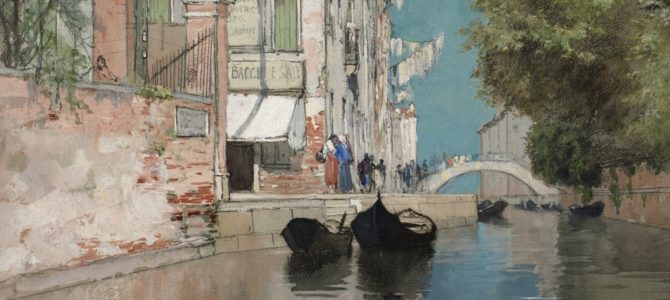
The exhibition “Sargent, Whistler, and Venetian Glass: American Artists and the Magic of Murano,” which just opened at the Smithsonian American Art Museum (SAAM) here in Washington, D.C., comes at a fitting time as more and more Americans are venturing out of their Covid cocoons and traveling internationally again. Even if you can’t board that flight or cruise to La Serenissima just yet, an in-person or virtual visit to this exhibition dazzles the eye and provides a good example of how the sum of a particular show can be of greater value than some of its individual components.
After the Civil War, Americans began moving about the globe in ever-increasing numbers, and Venice was one of the top destinations on the bucket list of nearly every traveler crossing the Atlantic. What did 19th-century Americans go to Venice to find?
Artists went in search of one of Venice’s greatest natural treasures: its famous light, and how it reflected off of the sea and the canals onto the ancient structures. They also went to study the works of the great Venetian masters, such as the Bellinis, Giorgione, and Tintoretto.
The more intrepid and innovative among them, including Robert Frederick Blum (1857-1903), John Singer Sargent (1856-1925), and James Abbott McNeill Whistler (1834-1903), headed into the back streets and forgotten corners of the city, to observe ordinary people and their less-than-palatial surroundings.
Underlying motivations for the visits of newly wealthy American collectors were more of a mixed bag. Some, no doubt, went for the pleasures of experiencing the culture of another place; they had duly read their John Ruskin and rented rooms in a palazzo on the Grand Canal. Others went, as indeed they do today, knowing little or nothing about Venice other than the fact that Jerry and Margo went there last year.

While American artists were bringing back new ways of thinking and creating new works of art based on what they had seen, American tourists needed to bring back their own treasures to demonstrate they had the means and the taste to be able to visit and appreciate Venice. If a work of art could not be obtained at a reasonable price, then a hand-made glass objet d’art, carefully selected at one of the many glassblowing factories on the Venetian island of Murano, would do the trick. Bringing all of these treasures, and the thinking behind them, together under a single umbrella is the challenge this show faces, and for the most part, it succeeds.
Treasures from Venice
The journey most Americans took to and from Venice during the latter part of the 19th century is laid out in the exhibition design. Visitors enter into a kind of establishing space, surrounded by images of Venice and its citizens at quayside, then move through displays of images and objects to be found on the streets of the city. They finally head home with their treasures, where eventually the influence of Venice makes inroads into the collective American consciousness. It’s an effective way to demonstrate how these travelers, whether artists, collectors, or tourists, were captivated by the charms of Venice, and tried to hold on to some of its fleeting magic.
If the museum’s evocation of a trip to Venice is successful, the space within which the visitor takes that journey is unfortunately not especially so. The show is displayed at ground level in what presumably were, at one time, stables or storage rooms. Not only does this mean the ceiling heights in the galleries are low, but also the only natural light comes from a few, very small, basement access windows.
While an effort was made to bring in some of the rich colors of both Venice and the Aesthetic Movement, such as wall-sized photographs of damask or rich paint colors, the lack of vertical space means some of the pictures are hung far too low on the walls, while seeing the Murano and other glass objects depends almost entirely upon artificial light.
Not Much Whistler, But Fabulous Sargents
Despite the exhibition’s title, Whistler’s Venetian-themed works in the show are somewhat underwhelming. Again, this isn’t the museum’s fault: Whistler only spent about a year and a half in Venice, and although he was productive during his time there, his output was primarily smaller-scale works on paper.
True, Whistler’s influence and presence, or at least his visage, loom large over the show, including portraits of the artist painted by other hands. That includes the splendid, seated portrait of Whistler by Giovanni Boldoni (1842-1931) from the Brooklyn Museum, which dominates one of the galleries.

Yet there was a layout choice to be made here. When the bulk of the 150 objects on display are sparkling glass and mosaics, complimented by bold paintings in heavily carved, gilded frames, from a distance the brownish Whistler etchings look a bit like flecks of mud splattered on a jeweled necklace. Segregating the works on paper from those on canvas, rather than intermingling them, might have proven less distracting.
Fortunately, the selection of Sargent’s works in the show exceeds expectations, as it inevitably does. The full-length portrait of “A Venetian Woman” (1882) from the Cincinnati Art Museum for example, which serves as the cover for the exhibition catalog, perfectly demonstrates what Baldassare Castiglione in the Renaissance termed “sprezzatura”: a kind of careless elegance, that belies the effort involved in achieving the end result. Sargent needed countless hours of practice and study, combined with God-given talent, to achieve details such as the slippery fringes of the purple shawl trailing off of the girl’s shoulder and sticking to the ruffles on her white dress.

Two other works by Sargent in the exhibition are particularly worthy of note, as they are not only beautiful, but also hail from private collections—meaning you should see them while you can. “Corner of the Church of San Stae” (1913), a late Sargent from a private collection, shows the brilliant Venetian light mentioned above bouncing off grand architecture and a clapped-out old boat. However, in its cropped layout and unusual perspective, it’s not the kind of painting that would have pleased a tourist collector looking for an easily recognizable depiction of Venice.
Similarly, “Leaving Church, Campo San Canciano, Venice” (c. 1882) from the renowned American Impressionists collection of Houstonians Marie and Hugh Halff, is not, as the catalog points out, the sort of “quaint” travel picture that would have appealed to conventional tastes. Sargent paints a scene of everyday urban life in a gritty, unremarkable corner of a city normally thought of for its architectural splendor.

The group of three women in the foreground, followed at some distance by a solitary female figure, are coming out of Mass, covered with their shawls on a gray and windy winter day. The surroundings are dirty and crumbling, and there are no colorful flower boxes or soaring monuments, but even in the relative drabness of these figures there is both a flash of vibrant Venetian color, in the bits of scarlet red clothing that peek out from the blacks, grays, and whites, and a kind of processional monumentality in their path across the square.
Views of Venice in Paint and Glass
Perhaps both more expected for its time period and yet somehow surprising given who painted it is a magnificent “View of Venice” (1891) from the SAAM’s permanent collection by the great American landscape painter Thomas Moran, one of the principal figures of the Hudson River School. Moran paid many visits to the city later in his career, and like other painters of Venetian cityscapes before him, including Canaletto and Turner, he sometimes rearranged elements of the skyline to achieve a more aesthetically pleasing result.

As in Moran’s much better-known views of the Rockies, the intense sky blues and rusty oranges in this work practically leap off the canvas and draw in the eye. During my visit, it was almost difficult to stand back and admire the picture because so many visitors crowded around.
That intensity of color brings us, inevitably, to consider the often intensely colored objects made of Murano glass displayed throughout the exhibition. Full disclosure: I have little knowledge of glass, whether from Venice or anywhere else, so must leave it to others to describe the methods employed for making these often impossible-seeming objects. That said, the exhibition helpfully provides a range of what we might call reference glass, such as rare examples from Ancient Rome, which we can compare to the objects produced many centuries later on Murano.

Between bumpy carriages, rattling rails, and the undulations of the sea, no doubt many such pieces from Murano did not survive the journey back to Memphis. As the exhibition points out, while even an expensive piece of Murano glass would not carry as high a price tag as, say, a Titian, for well-to-do travelers who were not quite at the level of a Morgan or a Vanderbilt, these objects became ways to show off one’s taste (and means) to the neighbors.
Even those who did in fact buy Titians from time to time, such as Mrs. Gardner up in Boston, also picked up examples of the Murano glassmakers’ art to enjoy for its own sake, as well as no doubt to show society frenemies when they came to call.
Colorful Ripples Across American Society
As more of these objects entered American collections, a greater interest in and awareness of Venetian design had a ripple effect across American society. Venetian-style buildings became popular, and of course any fake palazzo needed plenty of Venetian glass mosaic to go inside it. The best would be commissioned from one of the Murano glass factories and imported, but eventually American companies began imitating it as well.
Even structures or subjects that had no obvious connection to Venice sometimes came to have Venetian-style decoration, often in surprising ways, such as in the glass mosaics of President Abraham Lincoln from the U.S. Senate Collection, and that of President Theodore Roosevelt from the Corning Museum of Glass. The Lincoln portrait with its chunky gold backdrop looks somewhat disturbingly like a Byzantine religious mosaic from the Basilica of San Marco, while the Roosevelt portrait presents us a more realistic Teddy in living color, set against a kind of lagoon-like blue glass background that shimmers.

While today in more minimalist surroundings we might see some of these incredibly ornate objects as gaudy, there are parallels to this 19th-century fascination with the handmade in our contemporary appreciation for craftsmanship. Not only do museum and gallery exhibitions today celebrate artisans in materials such as glass, metals, and wood, but we’ve seen a greater interest in bringing such craft to decorative objects and installations in both domestic and commercial settings. Turn on almost any home improvement show, attend an art auction, or flip through a lifestyle magazine, and it’s clear there’s market interest in unique, complex objects created from even the most basic of raw materials.
Although not without its flaws, from pictures ranging from the grand to the intimate, to astonishing decorative objects, to even examples of highly sought-after Venetian lace, this exhibition is a satisfying introduction to and overview of the artistic connections between America and Venice at the turn of the previous century. What’s more, its large, beautifully illustrated catalog is a handsome addition to the home art history library. Just make sure you don’t prop it up with a piece of Murano glass.
“Sargent, Whistler, and Venetian Glass: American Artists and the Magic of Murano” is at the Smithsonian American Art Museum now through May 8, 2022. After that, it will travel to the Amon Carter Museum of American Art in Fort Worth, Texas from June 25, 2022 to September 11, 2022.









